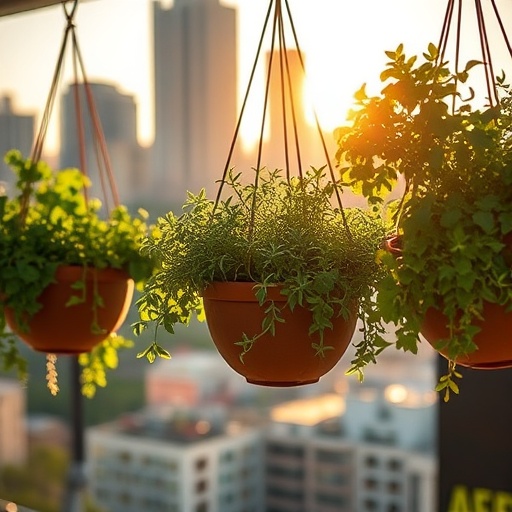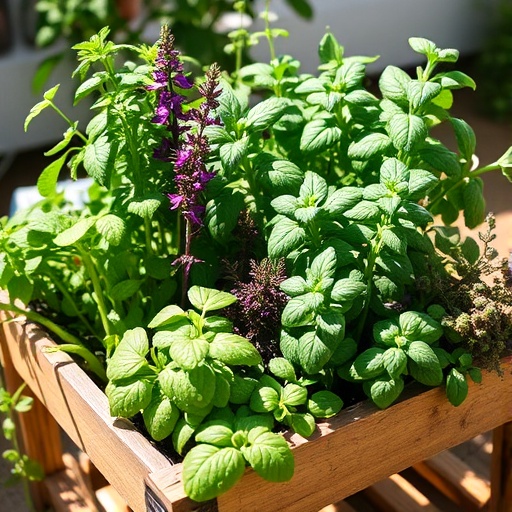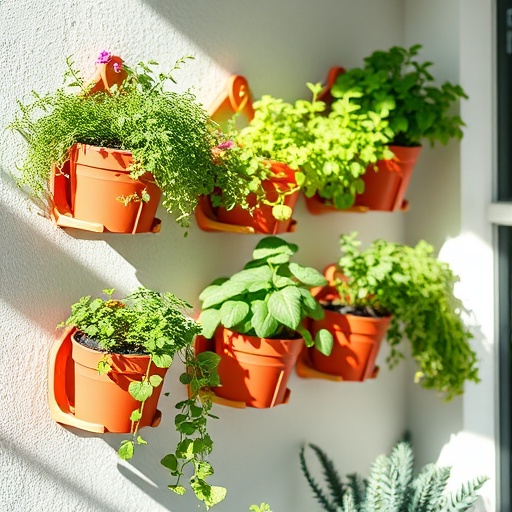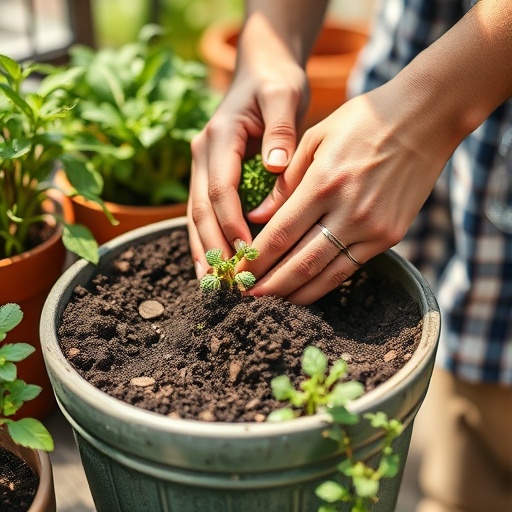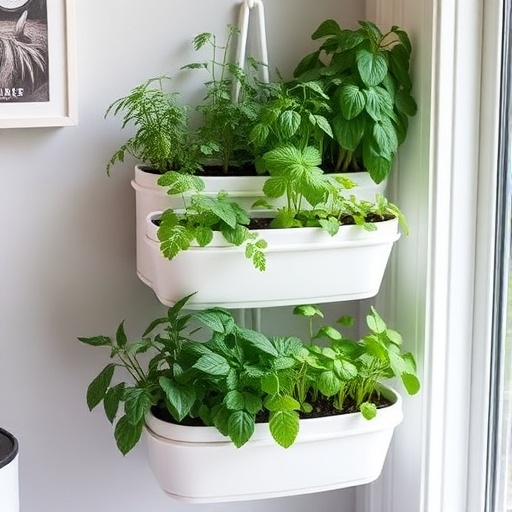Introduction
Do you ever gaze at your empty balcony or rooftop and wonder if it could be more than just extra space – perhaps a lush, green oasis filled with fresh herbs? Many urban dwellers believe a thriving garden is only for those with sprawling backyards. We’re here to challenge that notion and show you how transforming your outdoor living area into a vibrant balcony & rooftop garden is not only possible but incredibly rewarding. Imagine snipping fresh basil for your pasta, plucking mint for your tea, or harvesting chives for your morning eggs, all from your very own hanging planters. This guide will walk you through creating your DIY hanging herb planters, perfect for any balcony & rooftop garden, making fresh herbs an everyday luxury.
Tools & Materials Needed
Embarking on your hanging herb planter journey requires a few essential items, but don’t worry, most are easy to find and many can be repurposed!
- Planters: Choose lightweight options like plastic pots, fabric grow bags, or even repurposed food containers (yogurt tubs, milk jugs). For a more aesthetic appeal, terracotta or ceramic pots work well, but ensure they have drainage holes. Fabric grow bags are an eco-friendly favorite, promoting air pruning and preventing root circling, leading to healthier plants.
- Hanging Mechanisms: Strong S-hooks, macrame plant hangers (DIY or store-bought), sturdy rope or chain, and wall brackets or ceiling hooks are crucial. Ensure whatever you choose can support the weight of a wet pot filled with soil and a mature plant.
- Drill with appropriate bits: For creating drainage holes in plastic containers or pilot holes for hooks.
- Potting Mix: A high-quality, well-draining potting mix is indispensable. Look for mixes specifically designed for containers, often containing perlite or vermiculite to improve aeration. Avoid heavy garden soil, which can compact and suffocate roots in pots.
- Herb Seeds or Seedlings: Start with what you love! Popular choices for balcony & rooftop gardens include basil, mint, chives, oregano, thyme, rosemary, and parsley. Seedlings provide a quicker harvest, while seeds are more budget-friendly and offer the satisfaction of watching your plants grow from scratch.
- Trowel or small shovel: For handling soil.
- Gardening gloves: To protect your hands.
- Watering can with a fine rose: For gentle watering.
- Optional – Eco-friendly alternatives: Consider using reclaimed wood planks for a vertical garden structure, recycled plastic bottles as self-watering planters, or even old tires if space and aesthetics permit for a larger, more robust balcony & rooftop garden. For potting mix, you can amend a cheaper base with homemade compost for added nutrients.
Time & Effort Overview
Creating your DIY hanging herb planters is a wonderfully accessible project, even for absolute beginners.
Initial Setup: Expect to spend about 1-2 hours for assembling your planters and planting your herbs. This includes gathering materials, preparing the planters, filling with soil, and planting.
Growth & First Harvest:
- Seeds: Most herbs grown from seed will be ready for a light harvest in 4-8 weeks. Think of basil, which can be picked when it has 6-8 true leaves.
- Seedlings: If you opt for seedlings, you could be harvesting as early as 2-3 weeks after planting, depending on their size at purchase. This is significantly faster, giving you that instant gratification. For comparison, growing tomatoes from seed to first harvest typically takes 8-12 weeks, making herbs a much quicker turnaround!
Daily Maintenance: A mere 5-10 minutes daily or every other day, primarily for watering and a quick check for pests or problems.
Weekly Maintenance: Around 15-30 minutes for pruning, feeding, and more thorough pest inspections.
Difficulty Level: This project is firmly Beginner-Friendly. The steps are straightforward, and herbs are generally forgiving plants, making them ideal for new gardeners looking to explore the potential of their balcony & rooftop garden.
Step-by-Step Gardening Process
Prepare Your Planters
If using plastic containers, drill several drainage holes (at least 1/4 inch in diameter) in the bottom. Good drainage is paramount to prevent root rot. If using terracotta, ensure it has a drainage hole already. For fabric grow bags, drainage is naturally excellent. Clean any repurposed containers thoroughly before use.
Assemble Your Hanging Mechanism
Decide where you want your planters to hang. Attach your ceiling hooks or wall brackets securely, ensuring they are drilled into studs or use appropriate anchors to hold the weight. For macrame hangers, thread your pots into the hanger carefully. If using S-hooks, attach them to a railing or existing structure on your balcony. Always double-check stability; a falling planter can cause damage and heartbreak!
Fill with Potting Mix
Fill your prepared planters with your chosen potting mix, leaving about an inch or two of space from the rim. This space, known as the “headroom,” prevents water and soil from overflowing when you water. Lightly moisten the soil before planting; it makes for a more welcoming environment for your new herbs.
Plant Your Herbs
If using seeds, follow the packet instructions for depth and spacing. Many herb seeds are tiny and simply need to be sprinkled on the surface and lightly covered. If using seedlings, gently remove them from their nursery pots, being careful not to disturb the roots too much. Dig a small hole, place the seedling in, and backfill with soil, gently firming around the base. Don’t worry if a few tiny roots break; herbs are resilient.
Water Thoroughly
After planting, give your herbs a good, deep watering. This helps settle the soil around the roots and eliminates any air pockets. Use a watering can with a fine rose to prevent dislodging small seeds or delicate seedlings. The water should drain through the bottom, indicating good drainage.
Hang Your Planters
Once planted and watered, carefully hang your planters in their designated spots. Distribute the weight evenly if you’re hanging multiple planters from a single support structure. Step back and admire your handiwork – you’ve just brought life to your balcony & rooftop garden!
Growth & Care Tips
Consistent care is the secret to a thriving balcony & rooftop garden. Here’s how to keep your herbs happy:
- Watering Frequency: This is perhaps the most critical aspect. Herbs in containers, especially hanging ones exposed to more air circulation, tend to dry out faster than garden beds. Check the soil daily by sticking your finger an inch or two into the soil. If it feels dry, it’s time to water. Brown, crispy leaves often indicate underwatering, while yellowing, wilting leaves can be a sign of overwatering (which often leads to root rot). As a general rule, during warmer months, you might need to water daily; in cooler weather, every 2-3 days might suffice. Did you know overwatering is responsible for up to 60% of houseplant fatalities? It’s often misunderstood as insufficient watering, but the signs are quite different!
- Sunlight Exposure: Most herbs are sun-loving plants and thrive with 6-8 hours of direct sunlight per day. Basil, rosemary, and thyme, for example, absolutely adore bright sun. Mint can tolerate a bit more shade, making it versatile. Observe your balcony & rooftop garden throughout the day to identify the sunniest spots. If your balcony is north-facing or mostly shaded, consider herbs that tolerate lower light, such as parsley.
- Pruning & Harvesting: Regular pruning encourages bushier growth and prevents herbs from “bolting” (going to seed) which can make leaves less flavorful. For most herbs, simply snip off the top few sets of leaves, just above a leaf node. Never remove more than one-third of the plant at a time. Harvest from the top and sides, rather than just stripping the bottom leaves.
- Fertilization: Potted plants deplete soil nutrients faster than those in the ground. Use a balanced liquid organic fertilizer every 2-4 weeks during the growing season (spring and summer). Follow the product instructions for dilution. Avoid over-fertilizing, which can burn roots.
- Pest Prevention: Hanging planters can offer some protection from ground-dwelling pests, but aerial visitors like aphids, spider mites, and whiteflies can still be an issue. Regularly inspect the undersides of leaves. If you spot pests, a gentle spray of insecticidal soap or neem oil can often resolve the problem. Companion planting, like marigolds near your herbs, can also deter pests naturally.
Eco-Friendly & Sustainable Alternatives
Making your balcony & rooftop garden sustainable is not just good for the planet; it’s often more cost-effective and creates a healthier environment for your herbs.
- Composting: Start a small worm farm or a countertop compost bin for kitchen scraps. The “black gold” (compost) produced can be mixed into your potting soil, reducing the need for purchased fertilizers and enriching your soil naturally. It’s an excellent way to turn waste into a valuable resource for your balcony & rooftop garden.
- Natural Fertilizers: Beyond compost, consider using diluted fish emulsion, seaweed extract, or even used coffee grounds (for acid-loving plants) as natural nutrient boosters. Eggshells, when crushed and added to the soil, provide calcium, which can prevent blossom end rot in fruiting varieties you might expand to later.
- Water Conservation:
- Self-watering planters: These systems, whether DIY or store-bought, reduce evaporation and ensure plants get consistent moisture.
- Mulch: A layer of mulch (like wood chips or straw) on top of your soil in larger planters helps retain moisture, especially in hot urban environments, reducing watering frequency by up to 50%.
- Rainwater collection: If feasible on your balcony, a small rain barrel can provide free, chlorine-free water for your plants.
- Seed Saving: For open-pollinated herbs, let some go to flower and then to seed. Collect and store these seeds for next year’s planting. This not only saves money but also helps adapt your specific herb varieties to your unique balcony & rooftop garden microclimate over time.
- Repurposing: Continuously look for items around your home that can be repurposed. Old colanders make fantastic hanging planters with built-in drainage. Worn-out fabric tote bags can be cut and sewn into durable grow bags.
Creative Ideas & Uses
Your hanging herb planters are not just practical; they’re beautiful additions to your outdoor living space!
- Aesthetic Groupings: Group herbs with similar care needs together. For instance, Mediterranean herbs like rosemary, thyme, and oregano all love sun and drier conditions. Arrange them at varying heights for visual interest.
- Color & Texture: Combine herbs with different leaf textures and colors. A mix of bright green basil, silvery lamb’s ear (though not an herb, it offers stunning texture), and purple sage creates a captivating visual display.
- Decorative Hangers: Elevate your hangers! Macrame is popular, but consider woven baskets, ceramic pots with intricate patterns, or even upcycled metal containers painted in vibrant colors to match your outdoor decor.
- Edible Landscaping: Beyond just culinary use, many herbs produce beautiful flowers that attract pollinators like bees and butterflies, turning your balcony & rooftop garden into a mini-ecosystem. Chive blossoms are edible and add a splash of purple, while dill flowers attract beneficial insects.
- Vertical Gardens on a Balcony: If you have wall space, consider mounting a vertical planter system. This allows you to stack multiple herbs, maximizing your growing potential in a compact balcony & rooftop garden. You can easily build one from pallets or a series of connected individual planters. Visit Pinterest for more inspiring ideas! (https://www.pinterest.com/janatjanay47/)
Common Mistakes to Avoid
Even experienced gardeners make mistakes, but knowing what to watch out for can save you a lot of frustration.
- Overwatering: As mentioned, this is a silent killer. Drowning roots can’t access oxygen, leading to root rot. Signs include yellowing leaves, slowed growth, and damp, heavy soil. Always check soil moisture before watering.
- Insufficient Drainage: Without drainage holes, water accumulates at the bottom of the pot, creating anaerobic conditions that starve roots. If your chosen planter doesn’t have holes, drill them!
- Crowding Plants: While it’s tempting to cram as many herbs into one pot as possible, plants need space for air circulation and root development. Overcrowding leads to competition for nutrients, stunted growth, and increased susceptibility to fungal diseases. Give each plant room to breathe.
- Ignoring Sunlight Needs: Placing a sun-loving herb in too much shade will result in leggy, weak growth and poor flavor. Conversely, shade-loving herbs scorch in direct, intense sun. Match the herb to its light requirements for your specific balcony & rooftop garden.
- Neglecting Pruning: Afraid to cut your precious plants? Don’t be! Regular pruning is essential. Without it, herbs can become leggy, woody, and stop producing flavorful new growth. Basil, for instance, needs consistent pinching back to prevent it from going to seed too early.
- Using Garden Soil: Garden soil is heavy and compacts easily in pots, preventing proper drainage and aeration. Always opt for a quality potting mix designed for containers.
Maintenance & Storage Tips
Long-term success in your balcony & rooftop garden hinges on consistent, thoughtful maintenance.
- Seasonal Care:
- Spring: This is prime planting time! Refresh potting mix, plant new seeds or seedlings. Increase watering as temperatures rise.
- Summer: Daily watering might be necessary. Monitor closely for pests and prune regularly. Apply liquid fertilizer every 2-4 weeks.
- Fall: As temperatures drop, reduce watering. Consider bringing sensitive herbs like basil indoors if frost is expected. Hardier herbs like rosemary and thyme can often tolerate milder winters on a sheltered balcony.
- Winter: For outdoor herbs, assess hardiness. Some perennial herbs will go dormant and simply need minimal watering. For indoor herbs, ensure they still get adequate light (consider a grow light if needed) and maintain moderate humidity.
- Refreshing Potting Mix: After a season or two, the nutrients in potting mix become depleted, and the structure can degrade. Repotting with fresh potting mix or revitalizing the existing mix with compost is beneficial annually, especially for perennial herbs.
- Dealing with Yellow Leaves:
- Too much water: The most common cause. Check drainage and allow soil to dry out between waterings.
- Nutrient deficiency: A general yellowing evenly distributed across the plant, especially older leaves. Apply a balanced liquid fertilizer.
- Not enough light: Pale yellow leaves on plants that prefer sun. Relocate to a sunnier spot.
- Poor Soil Drainage: If water pools on the surface or takes a very long time to drain, your soil might be too compact or lack sufficient perlite/vermiculite. Gently aerate the soil with a chopstick or thin stick, or consider repotting with a better-draining mix.
Conclusion
Transforming your balcony & rooftop garden into a thriving haven of fresh herbs is not just a gardening project; it’s an investment in your well-being and a delightful daily convenience. You’ve learned that with just a few simple tools, a willingness to get your hands dirty, and a dash of creativity, anyone can cultivate an abundant herb garden, even in the most compact urban spaces. From preparing your planters and planting your chosen herbs to the nuanced art of watering, pruning, and pest management, you now possess the knowledge to nurture your greenery from seed to harvest.
Don’t let limited space deter you from the joys of homegrown goodness. The satisfaction of plucking fresh, aromatic herbs from your very own hanging planters is unparalleled. So, what are you waiting for? Grab your gardening gloves and start planting today! We’d love to see your creations! Share photos of your burgeoning balcony & rooftop gardens in the comments below or tag us on social media.
FAQ
Q1: What are the best herbs for a beginner to grow in a hanging planter?
A1: For a balcony & rooftop garden, chives, mint, basil, oregano, and thyme are fantastic choices for beginners. They are relatively forgiving, grow well in containers, and have distinct flavors that are rewarding to harvest.
Q2: How often should I water my hanging herb planters in summer?
A2: In the peak of summer, you might need to water daily, possibly even twice a day during heatwaves. Hanging planters dry out faster due to increased air circulation. Always check the soil moisture with your finger before watering – if the top inch or two feels dry, it’s time to water.
Q3: Can I use regular garden soil in my hanging planters?
A3: No, it’s highly recommended to use a high-quality potting mix specifically designed for containers. Garden soil is too dense and can compact easily, leading to poor drainage and suffocated roots in a balcony & rooftop garden environment.
Q4: My herbs are getting leggy and sparse. What am I doing wrong?
A4: Leggy growth often indicates either insufficient sunlight or a lack of proper pruning. Ensure your herbs are receiving at least 6-8 hours of direct sunlight. Regularly pinch back the growth tips to encourage bushier, more compact growth.
Q5: How do I protect my hanging herbs from pests?
A5: Regular inspection is key. Physically remove larger pests. For smaller infestations, a diluted insecticidal soap or neem oil spray applied to the tops and undersides of leaves can be very effective. Companion planting with pest-deterrent flowers like marigolds can also help in your balcony & rooftop garden.
Q6: Can I bring my outdoor hanging herbs indoors for winter?
A6: Yes, many herbs, especially tender perennials like basil and some mints, can be brought indoors before the first frost. Give them a good cleaning and check for pests first. Ensure they receive adequate light indoors, potentially supplementing with a grow light, and reduce watering frequency.
Q7: My hanging planter doesn’t have drainage holes. What should I do?
A7: You absolutely must add drainage holes. Use a drill with an appropriate bit to create several holes in the bottom of the planter. Without proper drainage, your herbs will almost certainly succumb to root rot, especially in a balcony & rooftop garden where container conditions are critical.
You may also enjoy reading these related guides:
